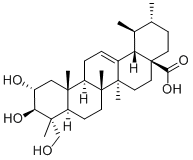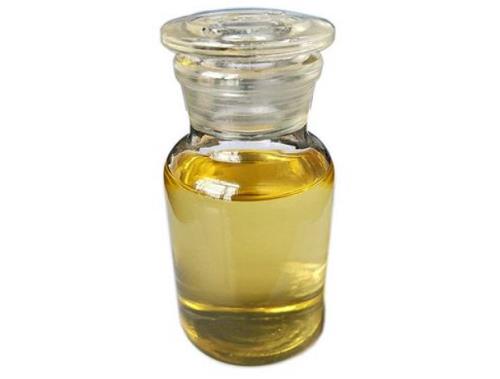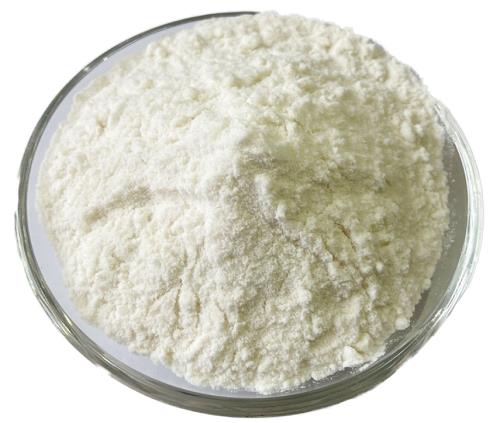Asiatic Acid: Neuroprotection & Anti-Inflammatory Activity
Asiatic acid (AA) is a natural aglycone of pentacyclic triterpenoids and is abundantly present in many edible and medicinal plants, including Centella Asiatica, which is a reputed herb for wound healing and neuropsychiatric disorders in many traditional medicine formulations. Asiatic acid has various pharmacological functions such as antioxidant and anti-inflammatory and controls apoptosis, which in numerous diseases credits to its medicinal impact. In preclinical trials, asiatic acid demonstrated potent antihypertensive, neuroprotective, cardioprotective, antidiabetic, antimicrobial, and antitumor behaviors. It has been shown to influence multiple enzymes, receptors, growth factors, transcription factors, apoptotic proteins, and cell signaling cascades in several in vitro and in vivo experiments.

Asiatic Acid Protects Dopaminergic Neurons from Neuroinflammation
Parkinson’s disease (PD) is the second most common neurodegenerative movement disorder after Alzheimer’s disease (AD), and is characterized by progressive loss of dopaminergic (DA) neurons in the substantia nigra pars compacta (SNpc) and accumulation of α-synuclein (α-syn) in Lewy bodies. Asiatic acid (AA) is one of the main triterpene components of Centella asiatica (L.) Urban. Clinical examinations have demonstrated protective effects of AA in the liver, nervous system and skin. Researchers have shown that AA can increase glutamate-induced brain damage and worsen memory function in mice. AA derivatives have been shown to counteract glutamate-induced excitotoxicity in nerve cells, while asiaticoside derivatives can antagonize β-amyloid-induced nerve damage. Despite the fact that Asiatic acid has demonstrated critical anti-inflammatory effects in the treatment of diseases such as PD, its anti-inflammatory mechanisms have not yet been clarified. Considering that the NLRP3 inflammasome plays a pivotal role in the inflammatory mechanism of neurodegenerative diseases like PD, whether Asiatic acid directly targets the NLRP3 inflammasome and inhibits activation to prevent PD warrants investigation. Taken together, we hypothesized that the protective mechanism of AA against PD might be through the inhibition of NLRP3 inflammasome activation, diminishing the inflammatory response to alleviate and improve PD symptoms.[1]
The present study was performed to determine whether AA had neuroprotective effects on both microglia and DA neurons in PD. We demonstrated that AA exerted partial neuroprotective effects in PD. AA pretreatment protected BV2 microglia cells from LPS-induced neuroinflammation damage, and protected DA neurons from MPP+-induced PD-like damage. We additionally found that Asiatic acid appeared to protect BV2 microglia cells from LPS-induced neuroinflammation by regulating mitochondrial dysfunction, and protected SH-SY5Y cells from MPP+-induced mitochondrial dysfunction, indicating the potential of AA as a prospective therapy for PD. In summary, our data demonstrate that AA protects BV2 microglia cells against LPS-induced neuroinflammation. Pretreatment with Asiatic acid suppressed cellular cytotoxicity, inhibited the release of mtROS and protected the mitochondria from dysfunction. We also affirmed that AA had protective effects against MPP+-induced DA neuron death. This study emphasizes that AA can suppress NLRP3 inflammasome activation and protect SH-SY5Y cells from MPP+-induced damage directly in PD. In-depth mechanistic studies of signal pathways to elucidate precise protective mechanisms of Asiatic acid against LPS-induced neuroinflammation in BV2 microglia cells, and the protective effects on MPP+-induced DA neuron death warrants further investigation.
Pharmaceutical Development of Asiatic Acid
In triterpenoids, Asiatic acid (AA), a pentacyclic triterpenoid has gained enormous attention due to its polypharmacological properties and therapeutic potential in numerous diseases. AA found in many edible and ornamental, which are popular in traditional medicines and contribute to their thrapeutic benefits. AA showed to modulate many enzymes, receptors, growth factors, transcription factors, apoptotic proteins, and cell signaling cascades, which attributes pharmacological effects. Until now, about 250 reports are available which demonstrate promising therapeutic indications, pharmacological effects, pharmacokinetic properties, physicochemical properties, and molecular mechanisms underlying the therapeutic benefits of Asiatic acid. In experimental studies, AA showed numerous pharmacological activities such as antioxidant, anti-inflammatory, hepatoprotective, cardioprotective, neuroprotective, gastroprotective, and anticancer properties. AA has been shown useful in wound healing, liver fibrosis, cerebral ischemia, dementia, hyperglycaemia, metabolic syndrome, obesity, Alzheimer's, and Parkinson's diseases. The plants containing Asiatic acid are in use in traditional and folk medicine for beneficial role in many diseases such as depression, memory, stress, wound healing, heart diseases, and cancer. These herbal preparations are available as ointment, dentifrice and cosmetic for dermal disorders, wound healing, venous insufficiency, and microangiopathy. The extract formulation of C. asiatica is available in the name of ECa 233 containing about 80% triterpenoid glycosides such as madecassoside (53.1%) and asiaticoside (32.3%).[2]
The beneficial effect of AA in inflammatory conditions in several experimental studies showed due to its capacity to regulate pro-inflammatory cytokines and preventing the development and progression of immune-inflammatory disorders. The NF-κB inhibitory activity of Asiatic acid was further supported by in silico and in vitro studies. The beneficial effect of AA in inflammatory conditions in several experimental studies showed due to its capacity to regulate pro-inflammatory cytokines and preventing the development and progression of immune-inflammatory disorders. The NF-κB inhibitory activity of Asiatic acid was further supported by in silico and in vitro studies. Imbalance in TGF-β/Smad signaling, reflected by activated Smad3 and inhibited Smad7 is a central mechanism of tissue fibrosis. AA attenuated unilateral ureteral obstruction-induced tubule interstitial renal fibrosis in mice. AA ameliorated increase tubular fibrosis by diminishing fibroblast activation and accumulation of extracellular matrix mediating Smad-dependent TGF-β1 signaling pathway. AA attenuated dextran sulfate sodium, a chemical colitogen induced ulcerative colitis in mice. The potential of AA in inflammatory bowel diseases was confirmed by improved disease activity index, inhibition of pro-inflammatory cytokines and reduced caspase-1 activation in peritoneal macrophages. Asiatic acid also prevented the secretion of IL-1β, activation of caspase-1 inflammasome.
Neuroprotective mechanisms of Asiatic acid
Asiatic acid (AA), the most crucial component of Asiaticoside, is a natural pentacyclic triterpenoid and the aglycone form of Asiaticoside. The chemical formula of AA is C30H48O5, with a molecular weight of 488.70 kD. Its formation occurs under acidic conditions by hydrolysis of the sugar portion of the Asiaticoside structure. Many edible and medicinal plants contain large quantities of AA, including Asiaticoside, a significant source of this compound. The previous studies indicate that AA can serve as a crucial multi-target drug of natural origin with various clinical applications. In addition, it has a wide range of biological activities, such as anti-inflammatory, antioxidant, anti-infective, and anti-tumor effects. Intensive studies in the past decades have revealed that Asiatic acid plays a crucial role in myocardial injury, hepatitis, osteoporosis, tumors, bacterial and fungal infection, skin diseases, wound healing, and diabetes. Furthermore, it has great potential in treating various neurological diseases such as spinal cord injury (SCI), neural tumors, traumatic brain injury (TBI), epilepsy, cerebral ischemia, Alzheimer's disease (AD), and Parkinson's disease (PD). Previous studies have shown that AA has anti-inflammatory, anti-apoptotic, and antioxidant effects, which protect against neurotoxicity and neurodegeneration.[3]
Oktay Gurcan et al. conducted a study on the therapeutic effect of Asiatic acid (75 mg/kg) on traumatic SCI in rats. They found an immediate reduction in the levels of pro-inflammatory cytokines such as TNF-α and IL1 and lipid peroxidation products such as MDA. Additionally, the recovery fraction of Tarlov function improved after AA treatment. An in vitro study conducted by Xu et al. demonstrated that Asiatic acid (at doses of 50 and 100 mg/kg) plays a crucial role in various processes, including protecting SH-SY5Y cells from glutamate-induced apoptosis, reducing ROS production, stabilizing mitochondrial membrane potential (MMP), and regulating the expression of Sirt1 and PGC-1α. In vivo study suggested that AA reduced glutamate-induced cognitive deficits in mice and restored lipid peroxidation, SOD, and glutathione activities to normal levels in the cortex and hippocampus.
References
[1]Chen D, Zhang XY, Sun J, Cong QJ, Chen WX, Ahsan HM, Gao J, Qian JJ. Asiatic Acid Protects Dopaminergic Neurons from Neuroinflammation by Suppressing Mitochondrial Ros Production. Biomol Ther (Seoul). 2019 Sep 1;27(5):442-449. doi: 10.4062/biomolther.2018.188. PMID: 30971058; PMCID: PMC6720531.
[2]Nagoor Meeran MF, Goyal SN, Suchal K, Sharma C, Patil CR, Ojha SK. Pharmacological Properties, Molecular Mechanisms, and Pharmaceutical Development of Asiatic Acid: A Pentacyclic Triterpenoid of Therapeutic Promise. Front Pharmacol. 2018 Sep 4;9:892. doi: 10.3389/fphar.2018.00892. PMID: 30233358; PMCID: PMC6131672.
[3]Ding L, Liu T, Ma J. Neuroprotective mechanisms of Asiatic acid. Heliyon. 2023 Apr 26;9(5):e15853. doi: 10.1016/j.heliyon.2023.e15853. PMID: 37180926; PMCID: PMC10172897.
You may like
See also
Lastest Price from Asiatic acid manufacturers

US $0.00/kg2025-04-28
- CAS:
- 464-92-6
- Min. Order:
- 1kg
- Purity:
- 0.99
- Supply Ability:
- 1000kg

US $1.00/KG2025-04-21
- CAS:
- 464-92-6
- Min. Order:
- 1KG
- Purity:
- 99%
- Supply Ability:
- 10 mt


